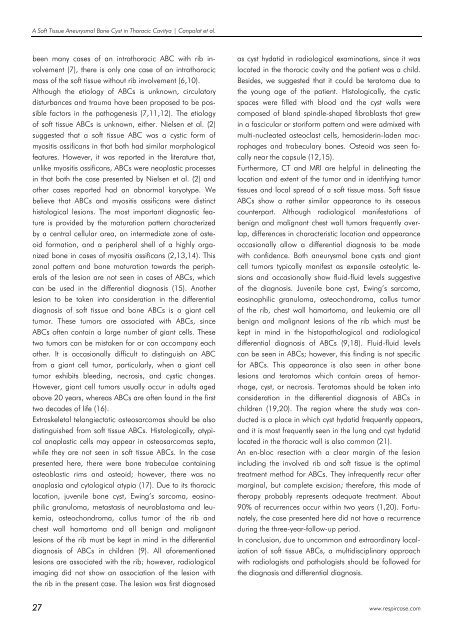Respircase Cilt: 6 - Sayı: 1 Yıl: 2017
You also want an ePaper? Increase the reach of your titles
YUMPU automatically turns print PDFs into web optimized ePapers that Google loves.
A Soft Tissue Aneurysmal Bone Cyst in Thoracic Cavitya | Canpolat et al.<br />
been many cases of an intrathoracic ABC with rib involvement<br />
(7), there is only one case of an intrathoracic<br />
mass of the soft tissue without rib involvement (6,10).<br />
Although the etiology of ABCs is unknown, circulatory<br />
disturbances and trauma have been proposed to be possible<br />
factors in the pathogenesis (7,11,12). The etiology<br />
of soft tissue ABCs is unknown, either. Nielsen et al. (2)<br />
suggested that a soft tissue ABC was a cystic form of<br />
myositis ossificans in that both had similar morphological<br />
features. However, it was reported in the literature that,<br />
unlike myositis ossificans, ABCs were neoplastic processes<br />
in that both the case presented by Nielsen et al. (2) and<br />
other cases reported had an abnormal karyotype. We<br />
believe that ABCs and myositis ossificans were distinct<br />
histological lesions. The most important diagnostic feature<br />
is provided by the maturation pattern characterized<br />
by a central cellular area, an intermediate zone of osteoid<br />
formation, and a peripheral shell of a highly organized<br />
bone in cases of myositis ossificans (2,13,14). This<br />
zonal pattern and bone maturation towards the peripherals<br />
of the lesion are not seen in cases of ABCs, which<br />
can be used in the differential diagnosis (15). Another<br />
lesion to be taken into consideration in the differential<br />
diagnosis of soft tissue and bone ABCs is a giant cell<br />
tumor. These tumors are associated with ABCs, since<br />
ABCs often contain a large number of giant cells. These<br />
two tumors can be mistaken for or can accompany each<br />
other. It is occasionally difficult to distinguish an ABC<br />
from a giant cell tumor, particularly, when a giant cell<br />
tumor exhibits bleeding, necrosis, and cystic changes.<br />
However, giant cell tumors usually occur in adults aged<br />
above 20 years, whereas ABCs are often found in the first<br />
two decades of life (16).<br />
Extraskeletal telangiectatic osteosarcomas should be also<br />
distinguished from soft tissue ABCs. Histologically, atypical<br />
anaplastic cells may appear in osteosarcomas septa,<br />
while they are not seen in soft tissue ABCs. In the case<br />
presented here, there were bone trabeculae containing<br />
osteoblastic rims and osteoid; however, there was no<br />
anaplasia and cytological atypia (17). Due to its thoracic<br />
location, juvenile bone cyst, Ewing’s sarcoma, eosinophilic<br />
granuloma, metastasis of neuroblastoma and leukemia,<br />
osteochondroma, callus tumor of the rib and<br />
chest wall hamartoma and all benign and malignant<br />
lesions of the rib must be kept in mind in the differential<br />
diagnosis of ABCs in children (9). All aforementioned<br />
lesions are associated with the rib; however, radiological<br />
imaging did not show an association of the lesion with<br />
the rib in the present case. The lesion was first diagnosed<br />
as cyst hydatid in radiological examinations, since it was<br />
located in the thoracic cavity and the patient was a child.<br />
Besides, we suggested that it could be teratoma due to<br />
the young age of the patient. Histologically, the cystic<br />
spaces were filled with blood and the cyst walls were<br />
composed of bland spindle-shaped fibroblasts that grew<br />
in a fascicular or storiform pattern and were admixed with<br />
multi-nucleated osteoclast cells, hemosiderin-laden macrophages<br />
and trabeculary bones. Osteoid was seen focally<br />
near the capsule (12,15).<br />
Furthermore, CT and MRI are helpful in delineating the<br />
location and extent of the tumor and in identifying tumor<br />
tissues and local spread of a soft tissue mass. Soft tissue<br />
ABCs show a rather similar appearance to its osseous<br />
counterpart. Although radiological manifestations of<br />
benign and malignant chest wall tumors frequently overlap,<br />
differences in characteristic location and appearance<br />
occasionally allow a differential diagnosis to be made<br />
with confidence. Both aneurysmal bone cysts and giant<br />
cell tumors typically manifest as expansile osteolytic lesions<br />
and occasionally show fluid-fluid levels suggestive<br />
of the diagnosis. Juvenile bone cyst, Ewing’s sarcoma,<br />
eosinophilic granuloma, osteochondroma, callus tumor<br />
of the rib, chest wall hamartoma, and leukemia are all<br />
benign and malignant lesions of the rib which must be<br />
kept in mind in the histopathological and radiological<br />
differential diagnosis of ABCs (9,18). Fluid-fluid levels<br />
can be seen in ABCs; however, this finding is not specific<br />
for ABCs. This appearance is also seen in other bone<br />
lesions and teratomas which contain areas of hemorrhage,<br />
cyst, or necrosis. Teratomas should be taken into<br />
consideration in the differential diagnosis of ABCs in<br />
children (19,20). The region where the study was conducted<br />
is a place in which cyst hydatid frequently appears,<br />
and it is most frequently seen in the lung and cyst hydatid<br />
located in the thoracic wall is also common (21).<br />
An en-bloc resection with a clear margin of the lesion<br />
including the involved rib and soft tissue is the optimal<br />
treatment method for ABCs. They infrequently recur after<br />
marginal, but complete excision; therefore, this mode of<br />
therapy probably represents adequate treatment. About<br />
90% of recurrences occur within two years (1,20). Fortunately,<br />
the case presented here did not have a recurrence<br />
during the three-year-follow-up period.<br />
In conclusion, due to uncommon and extraordinary localization<br />
of soft tissue ABCs, a multidisciplinary approach<br />
with radiologists and pathologists should be followed for<br />
the diagnosis and differential diagnosis.<br />
27 www.respircase.com

















